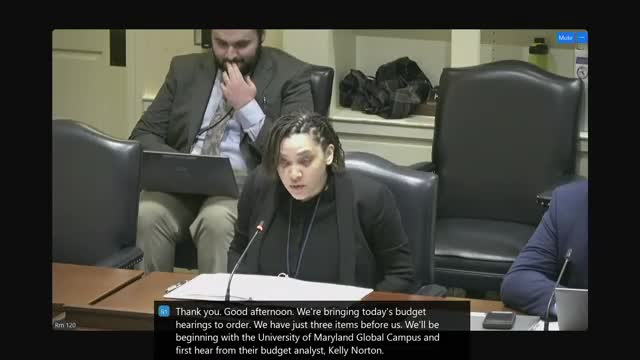UMGC reports 2.7% increase in undergraduate enrollment amid financial challenges
March 03, 2025 | Education and Economic Development Subcommittee, Appropriations Committee, HOUSE OF REPRESENTATIVES, Committees, Legislative, Maryland
Thanks to Scribe from Workplace AI , all articles about Maryland are free for you to enjoy throughout 2025!

This article was created by AI using a video recording of the meeting. It summarizes the key points discussed, but for full details and context, please refer to the video of the full meeting. Link to Full Meeting
The session opened with a report indicating that total undergraduate enrollment at UMGC rose by 1,394 students, or 2.7%, from fall 2023 to fall 2024, reaching a total of 52,187 students. Notably, while most categories of students saw increases, first-time full-time students did not follow this trend. The university's share of full-time equivalent (FTE) enrollment within the University System of Maryland has also grown, with UMGC now representing the largest portion of FTEs.
Retention rates for transfer students were a focal point of discussion, revealing a decline in second-year retention to 64% for the 2023 cohort, while third-year retention remained steady at 47% for the 2021 cohort. Graduation rates showed mixed results, with a six-year graduation rate for transfer students increasing to 26% for the 2019 cohort, but a decrease in the four-year graduation rate to 24% for the 2021 cohort.
Financially, UMGC reported a significant increase in institutional aid, rising from $13 million in fiscal year 2019 to $19.6 million in fiscal year 2024. This growth is attributed largely to merit-based scholarships, including the Maryland Completion Scholarship, which supports community college graduates in completing their bachelor's degrees affordably. The university's budget for fiscal year 2026 anticipates a decrease in total funding by $200,000, with state funds expected to drop by $2.6 million, raising concerns about how UMGC will manage these cuts.
President Fowler emphasized the importance of marketing in driving enrollment, noting that UMGC has spent approximately $326 million of a $500 million advertising budget authorized in 2019. This investment has reportedly resulted in an average annual increase of over 22,000 students. However, the university faces stiff competition from other institutions that spend significantly more on marketing.
The meeting also addressed the university's financial sustainability, particularly in light of recent audits that raised concerns about the management of its Higher Education Investment and Development Authority (HIDA) entities. Recommendations for improved transparency and fiscal oversight were discussed, with President Fowler affirming UMGC's commitment to compliance and addressing audit findings.
As the session concluded, President Fowler expressed gratitude for the state's support and reiterated UMGC's mission to provide accessible education to Maryland's diverse adult learner population. With over 111,000 UMGC graduates residing in Maryland, the university continues to play a vital role in the state's educational landscape, particularly for those balancing work and family commitments. The discussions at this meeting underscore the ongoing challenges and opportunities facing UMGC as it navigates the complexities of higher education in Maryland.
Converted from EED Committee Session, 3/3/2025 #1 meeting on March 03, 2025
Link to Full Meeting
Comments
View full meeting
This article is based on a recent meeting—watch the full video and explore the complete transcript for deeper insights into the discussion.
View full meeting